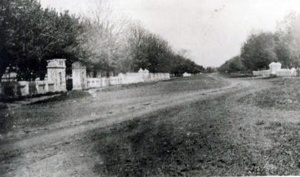Schönsee (Molotschna Mennonite Settlement, Zaporizhia Oblast, Ukraine)
Schönsee, a village in the Molotschna settlement, Taurida (now Zaporizhia Oblast in Ukraine), South Russia, situated about 70 miles from the seaport of Berdyansk at the Sea of Azov, was one of the 18 oldest villages of the Molotschna, founded in 1804-06 by Mennonite settlers from Prussia. In 1812, the site having been found unsuitable, the village was transferred to another site some ten miles east. A typical Molotschna village of medium size, it contained 20 farms of about 160 acres each and a number of smaller farms of 40 acres each. At the end of the village were a number of houses whose inhabitants possessed no land but were craftsmen of different kinds (see Anwohner). The total land area was 4,200 acres, the population around 500 souls, who before World War I were almost exclusively Mennonites. The village contained a general store, a small factory manufacturing agricultural machinery and employing around 30 workers, a large flour mill, a blacksmith shop, and outside the village on a hill a large windmill of the Dutch type. But this type of mill, of which there were several in the Molotschna, was not used for pumping water as in Holland but for milling feed grain on a large scale. The school contained two classrooms and employed two teachers. At the eastern end of the village stood the new church completed a few years before World War I.
With the Russian revolution hard times began for the villagers, and a general decline followed. During the Civil War in 1919, Schönsee for several months was in the front line between the warring armies and suffered considerable damage. A number of the inhabitants were killed. During the 1930's a great number of people, mostly men, who had been prosperous were branded "kulaks" and banished to Siberia. From the village of Schönsee alone this number reached 72.
Toward the end of World War II most of the remaining Mennonite inhabitants succeeded in escaping from Russia with the retreating German armies. But the greater part of these refugees were rounded up by the Russians in Poland and forcibly returned to Russia. As far as is known, they were not taken to their former homes but to Kazakhstan, a desolate province of central Asia. Only a very few inhabitants of Schönsee reached the Western Zone of Germany, from where in due time they immigrated to Canada or South America. The final fate of the village after the departure of the Mennonite population is unknown.
| Author(s) | Heinrich Goerz |
|---|---|
| Date Published | 1959 |
Cite This Article
MLA style
Goerz, Heinrich. "Schönsee (Molotschna Mennonite Settlement, Zaporizhia Oblast, Ukraine)." Global Anabaptist Mennonite Encyclopedia Online. 1959. Web. 21 Nov 2024. https://gameo.org/index.php?title=Sch%C3%B6nsee_(Molotschna_Mennonite_Settlement,_Zaporizhia_Oblast,_Ukraine)&oldid=104785.
APA style
Goerz, Heinrich. (1959). Schönsee (Molotschna Mennonite Settlement, Zaporizhia Oblast, Ukraine). Global Anabaptist Mennonite Encyclopedia Online. Retrieved 21 November 2024, from https://gameo.org/index.php?title=Sch%C3%B6nsee_(Molotschna_Mennonite_Settlement,_Zaporizhia_Oblast,_Ukraine)&oldid=104785.
Adapted by permission of Herald Press, Harrisonburg, Virginia, from Mennonite Encyclopedia, Vol. 4, pp. 474-475. All rights reserved.
©1996-2024 by the Global Anabaptist Mennonite Encyclopedia Online. All rights reserved.

